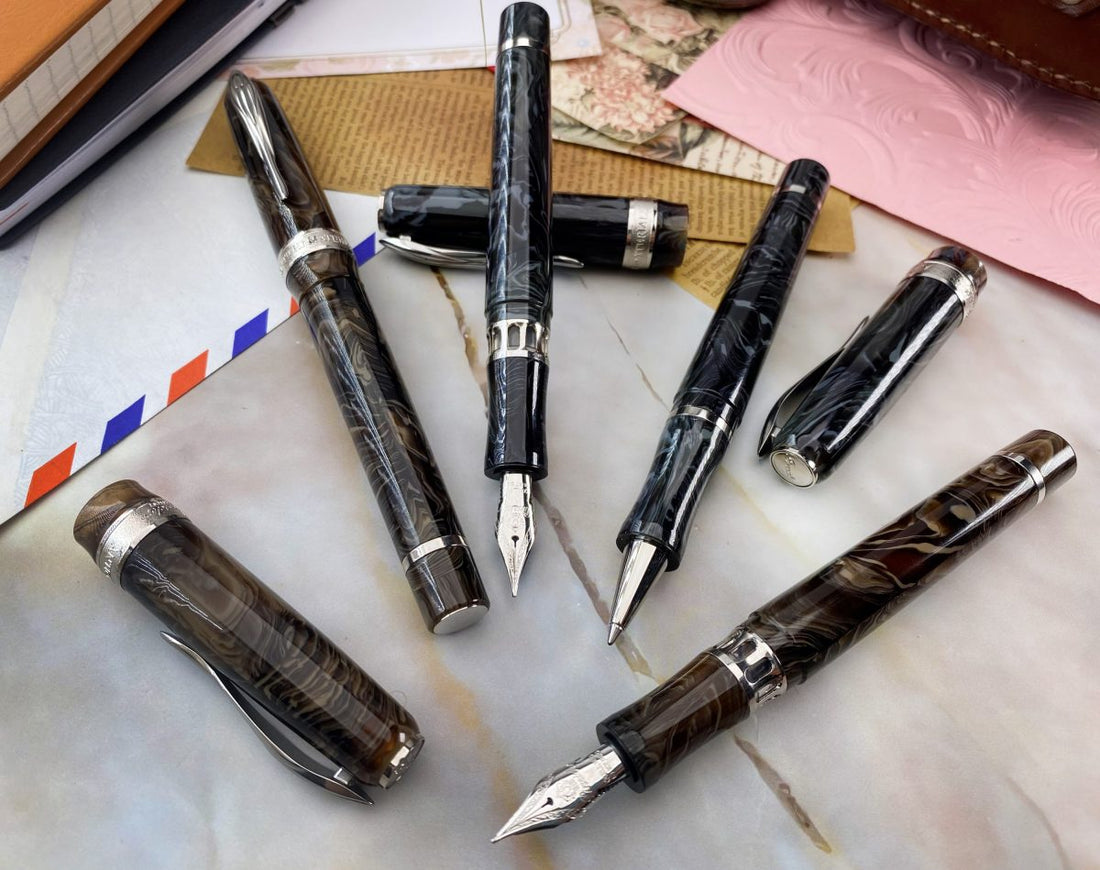
Pineider Ancient Materials Pen Collection
Share
Celluloid is a magic word for any pen collector. This word brings to mind not only the golden age of writing instruments, but also the transition spanning from the 1990s to the present day. The discovery of a stock of materials for eyewear, is for a pen company, how to win the lottery, because the materials for glasses were mainly non-flammable celluloid, bio plastic, nylon and acrylic. Pineider was able to successfully turn an old supply of materials into beautiful writing instruments. The Pineider Ancient Materials Pen Collection is made with the same production techniques utilized in the roaring twenties and with identical characteristics.
First, all known types of celluloid, Piralina, Rodolite, Permanite, Rhodoid, just to name a few, are all derived from the original formula of the Hyatt brothers: cellulose with the addition of a plasticizer that consolidates its structure. Notably, cellulose is made from cotton, which guarantees its purity, and not from wood as you might think. As you will see in the Pineider Ancient Materials Pen Collection, it’s available in two beautiful colors of celluloid: Brown and Grey. Above all, each is a limited edition of only 288 pieces made.
Secondly, the plasticizer, in the various formulas can be alcohol, acetic anhydride or plasticizers of natural origin (bio celluloid). Regrettably, the materials suitable for eyewear are often too thin for crafting writing instruments unless one employs long-forgotten techniques typical of pen production from the 1920s and possesses the expertise required to do so.
Importantly, throughout history, four primary techniques for creating celluloid pens have been recognized in pen literature: spiral wrap (spiral winding), funnel straight (funnel closure), flat mold (two-part seed press), and solid block methods. In addition, certain techniques allowed for material conservation and consistent decorative patterns across the pen’s entire 360 degrees. Notably, this avoids a side effect commonly seen in pens carved from solid blocks.
Available in fountain pen and rollerball, you have plenty of options. Both incorporate a smooth magnetic cap closure system. With the fountain pen, you can choose from extra fine, fine, medium, broad, and stub nibs. These are all 14k gold hyperflex quill nibs. For maximized efficiency, it’s equipped with a piston filling mechanism. The rollerball refills with Schmidt 888 or 5888 rollerball refills.
Finally, let us not forget the curing time. Employing a necessary maturing process to stabilize the material and complete the drying phase. In addition, this process typically spans from 3 to 8 months. It renders the material workable, followed by an additional month during part fabrication. Above all, celluloid and its family exhibit exceptional qualities, such as unparalleled durability, as exemplified by historic advertisements from the twenties, showcasing pens being thrown from planes or into the Grand Canyon to highlight this virtually unbreakable attribute. Moreover, the richness and diversity of colors offered by celluloid remain unmatched by any other material. Originally employed to imitate natural materials like tortoise shell or ivory, celluloid designers have unleashed their creativity. Therefore, this produces thousands of diverse effects, limited only by their imagination.
What do you think? Do you have yours yet? You can check it out here. Do you like what you’re reading? Subscribe to our blog to sign up! Don’t forget to comment and share on social media! What are some of the things you’d like to see reviewed?







